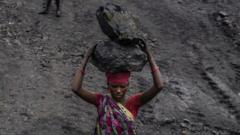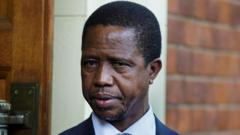The establishment of Bitcoin mining in Zengamina, Zambia, showcases an innovative use of renewable energy and highlights both the local benefits and broader implications of the cryptocurrency industry.
Bitcoin and Hydropower: A Unique Partnership in Zambia's Zengamina

Bitcoin and Hydropower: A Unique Partnership in Zambia's Zengamina
In remote Zambia, a Bitcoin mining operation is using hydropower from the Zambezi River, creating jobs and opportunities for the local community while discussing the sustainability and implications of cryptocurrency mining.
In the far northwestern reaches of Zambia, the Zambezi River blares its powerful roar, but this is not the only sound cutting through the enveloping wilderness. In stark contrast, the high-pitched whir of computers can be heard as a Bitcoin mining facility operates within a shipping container. Phillip Walton, an engineer from Gridless, oversees the site that houses 120 computers, diligently verifying Bitcoin transactions in exchange for the digital currency itself.
Located near the border with the Democratic Republic of the Congo, this remote operation attracts attention due to its unique access to a nearby hydroelectric power plant that harnesses the river's strength. This direct connection to clean and economical energy makes it feasible for Gridless, a Kenyan company, to transport its equipment 14 arduous hours from the nearest urban center to operate in this location. Each computer generates approximately $5 (£3.90) daily, a sum that can fluctuate with Bitcoin's market value.
The system’s profitability relies on an effective partnership with the hydroelectric facility. Built in the early 2000s with funds raised primarily through donations, Daniel Rea, the local site manager, explains that prior to Gridless’s arrival, the plant was wasting significant energy due to low community utilization. Regaining economic viability through the mining operation has transformed them into a financially stable entity, enabling lower prices for local electricity as Bitcoin revenue contributes to their operational costs.
Nevertheless, life for the local people still centers on basic amenities. The surrounding town, comprised of basic structures, reflects a community in transition. Residents like barber Damian, who recently gained access to electricity, appreciate the newfound convenience that power has brought to their lives. Even children who were once disconnected now find joy in technology, with access to mobile phones and a boost in communication abilities.
However, while the immediate economic advantages are clear, many locals remain unaware of the Bitcoin operation's role in stabilizing the local grid. As Zengamina Hydro plans to connect to the national grid, concerns arise about the mining operation becoming unfeasible. Gridless’s founders indicate that planned future expansions could involve deploying their hydro-plants, tapping into locations with abundant “stranded energy.”
Despite facing criticism for being energy-intensive, advocates argue that such operations can aid local economies, citing the need for a clear regulatory framework. The environmental and social implications of cryptocurrency mining continue to evoke debate, especially as energy concerns arise in other regions where mining has caused strain on local grids.
As Gridless looks to expand its models across Africa, its mission emphasizes not just profit, but also sustainable innovation in electricity provision. The evolving landscape of Bitcoin mining on the African continent garners interest not only from investors but also from local communities seeking improved energy solutions.
Located near the border with the Democratic Republic of the Congo, this remote operation attracts attention due to its unique access to a nearby hydroelectric power plant that harnesses the river's strength. This direct connection to clean and economical energy makes it feasible for Gridless, a Kenyan company, to transport its equipment 14 arduous hours from the nearest urban center to operate in this location. Each computer generates approximately $5 (£3.90) daily, a sum that can fluctuate with Bitcoin's market value.
The system’s profitability relies on an effective partnership with the hydroelectric facility. Built in the early 2000s with funds raised primarily through donations, Daniel Rea, the local site manager, explains that prior to Gridless’s arrival, the plant was wasting significant energy due to low community utilization. Regaining economic viability through the mining operation has transformed them into a financially stable entity, enabling lower prices for local electricity as Bitcoin revenue contributes to their operational costs.
Nevertheless, life for the local people still centers on basic amenities. The surrounding town, comprised of basic structures, reflects a community in transition. Residents like barber Damian, who recently gained access to electricity, appreciate the newfound convenience that power has brought to their lives. Even children who were once disconnected now find joy in technology, with access to mobile phones and a boost in communication abilities.
However, while the immediate economic advantages are clear, many locals remain unaware of the Bitcoin operation's role in stabilizing the local grid. As Zengamina Hydro plans to connect to the national grid, concerns arise about the mining operation becoming unfeasible. Gridless’s founders indicate that planned future expansions could involve deploying their hydro-plants, tapping into locations with abundant “stranded energy.”
Despite facing criticism for being energy-intensive, advocates argue that such operations can aid local economies, citing the need for a clear regulatory framework. The environmental and social implications of cryptocurrency mining continue to evoke debate, especially as energy concerns arise in other regions where mining has caused strain on local grids.
As Gridless looks to expand its models across Africa, its mission emphasizes not just profit, but also sustainable innovation in electricity provision. The evolving landscape of Bitcoin mining on the African continent garners interest not only from investors but also from local communities seeking improved energy solutions.





















